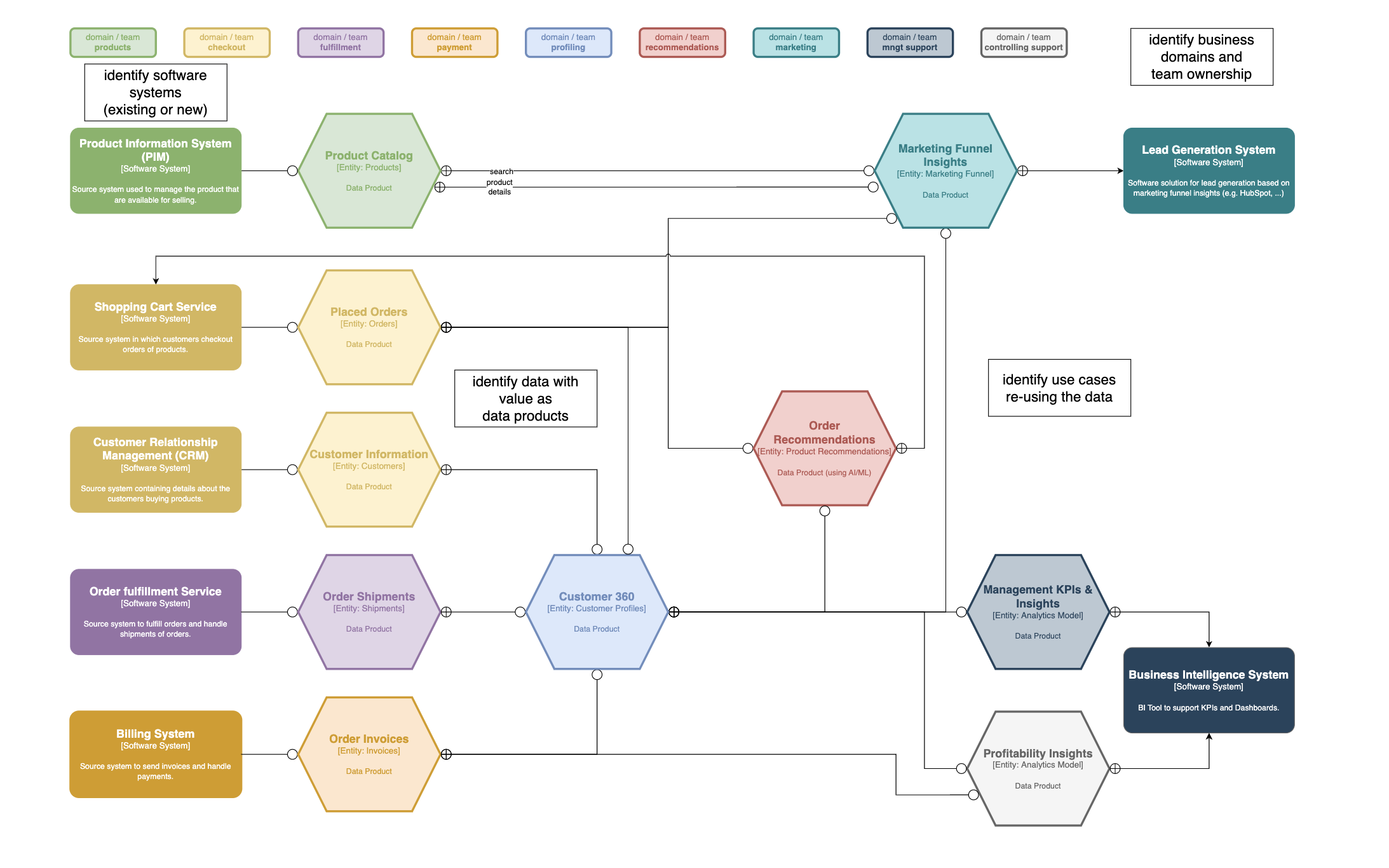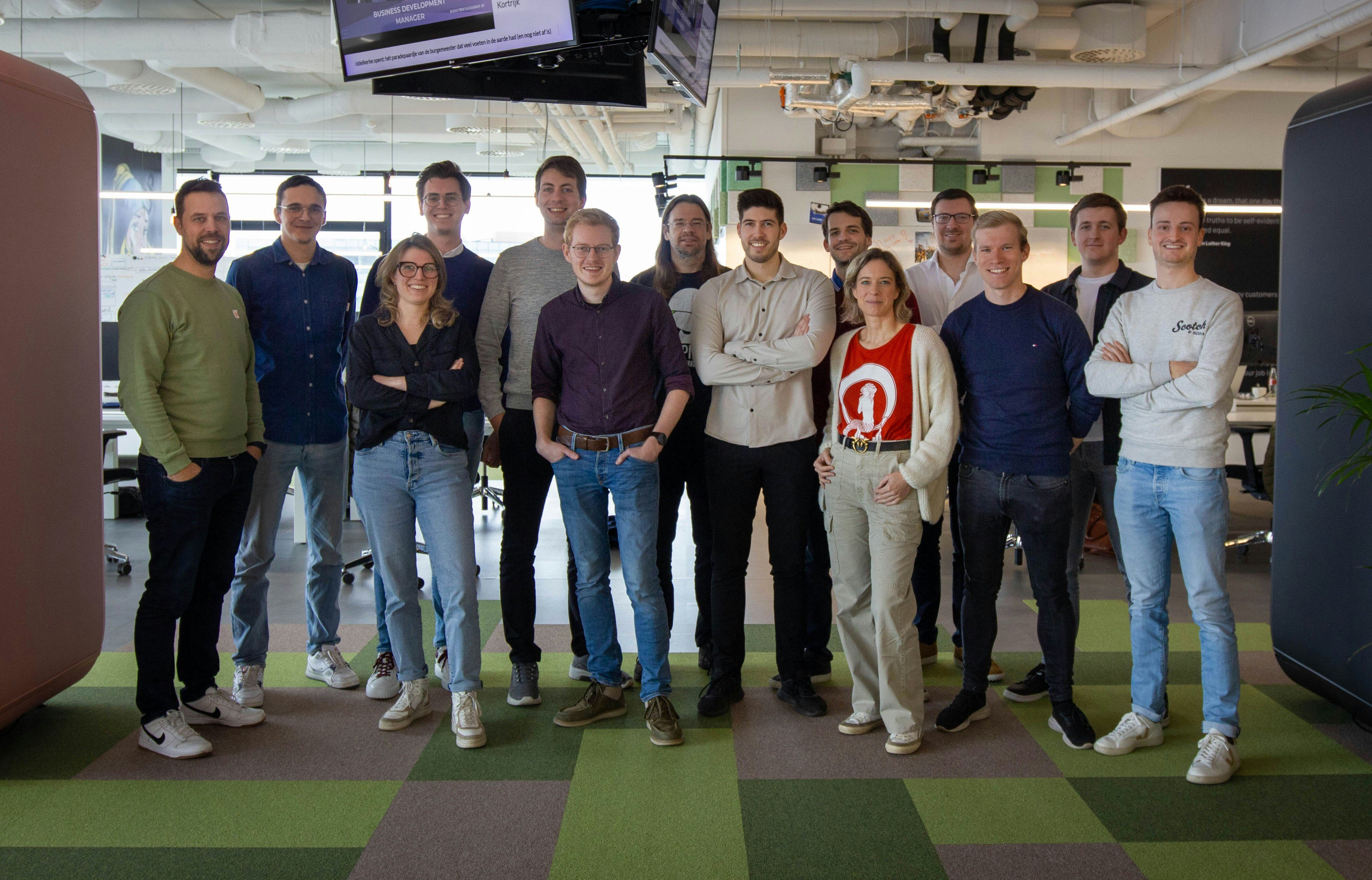
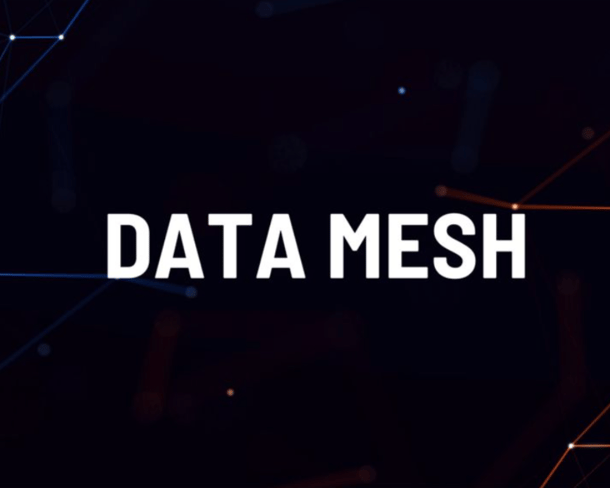
Make it concrete for all stakeholders
Data Mesh is frequently perceived as highly abstract and theoretical, leaving stakeholders uncertain about its precise implications and potential solutions. Therefore, at ACA Group, we focus on making it as concrete as possible for business stakeholders, technical stakeholders, and other impacted stakeholders in the organization.
We recommend simultaneously addressing three key challenges:
- IDENTIFY BUSINESS VALUE – Define how Data Mesh exactly contributes to the business value by considering data as a product.
- ORGANIZE TEAMS – Specify the role of every team, team member and persona within the context of Data Mesh.
- BUILD PLATFORM – Show how data mesh influences the technical architecture.
Challenge 1: Identifying the Data Mesh Business Value
One of the first challenges in adopting Data Mesh is to explain and prove its business value. At ACA Group, we start by identifying potential data products, domains, and use cases. This process is grounded in business input and results in a data product landscape. An example of an e-commerce company is shown below (boxes are applications, hexagons are data products, colors are owning domains). This landscape serves as a navigation map, inspiring new innovative business ideas and showcasing the value that Data Mesh can bring to the organization. By demonstrating how Data Mesh can enable new possibilities, we clarify its relevance to business stakeholders.
Aligning Data Mesh Solutions with Organizational Goals
To get the most out of Data Mesh, alignment with the organization's overall goals and strategy is paramount. It's essential to ensure that the investment in technology and process aligns with the broader business objectives. This alignment helps maintain support and momentum, crucial for realizing the success of a Data Mesh initiative.
Identifying Data Mesh Opportunities through Game Storming
At ACA Group, we apply game storming techniques to discover domains and data products. This process begins with business capabilities and data use cases identified through workshops, such as impact mapping. By aligning Data Mesh with these aspects, we identify a data product landscape from two perspectives: an inventory of available data and potential data products inspires and generates new business ideas, while the desired business impact and goals helps to identify required data and data products.
Challenge 2: Organizing Teams and Empowering Individuals
Data Mesh is not just about technology; it's about transforming how teams and team members operate within the organization. ACA Group believes in organizing teams effectively to harness the power of Data Mesh. We interact with existing teams and team members, positioning their valuable roles and expertise within a Data Mesh team organization. This typically involves platform teams, domain teams, enabling teams, and a federated governance team. Additionally, we explore the various user journeys and experiences for each persona, ensuring that Data Mesh positively impacts the organization, its people, and their roles.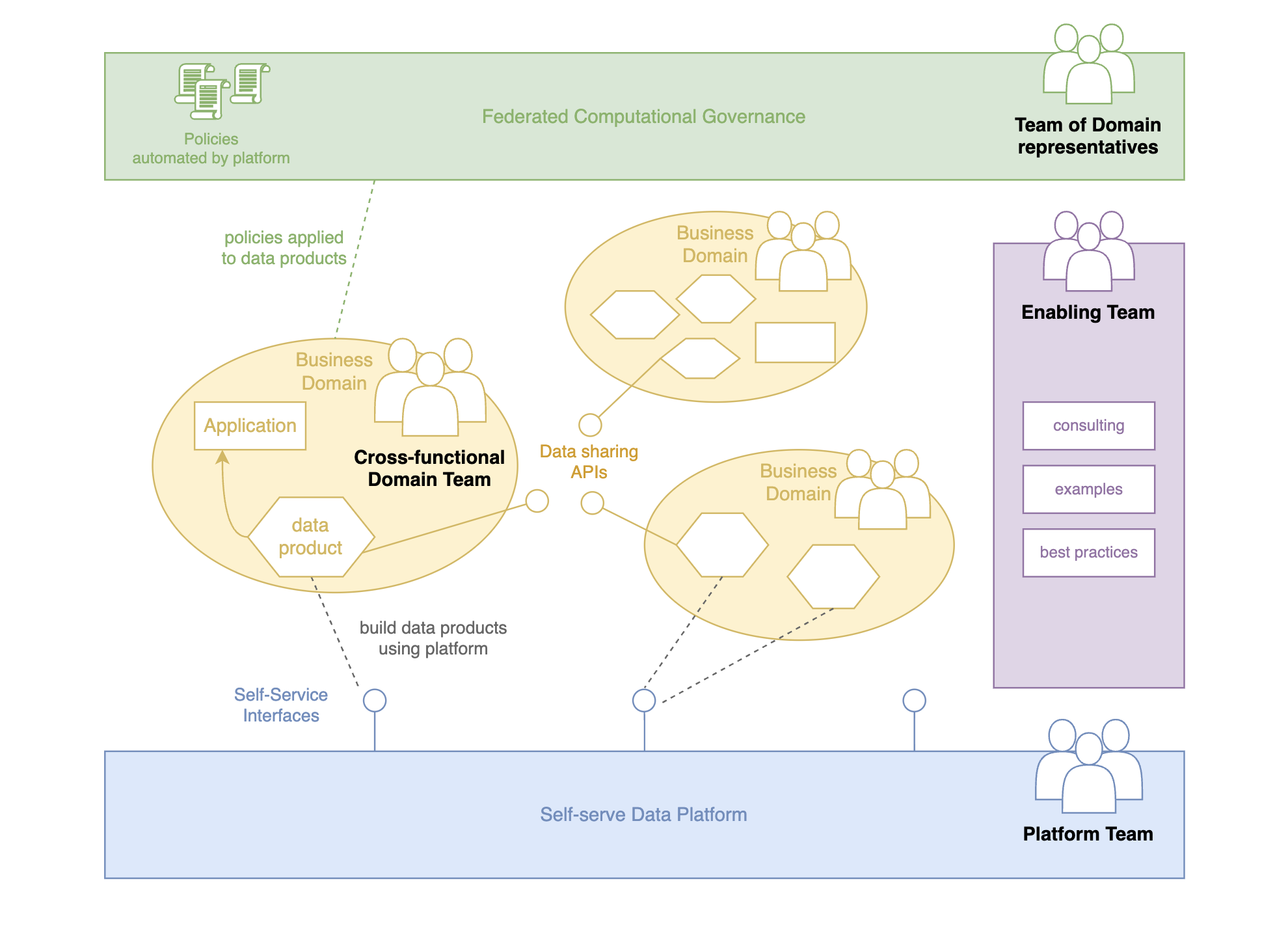
Challenge 3: Building the Technical Architecture as a First-Class Component
The technical architecture is a critical aspect of Data Mesh, and ACA Group is committed to making it a tangible reality. We demonstrate how Data Mesh can work in practice by developing a coded and working proof of concept. Leveraging our platform engineering expertise, we bring data products to life, showcasing how Data Mesh can leverage existing data technology while providing a future-proof and flexible architecture tailored to the client's unique context.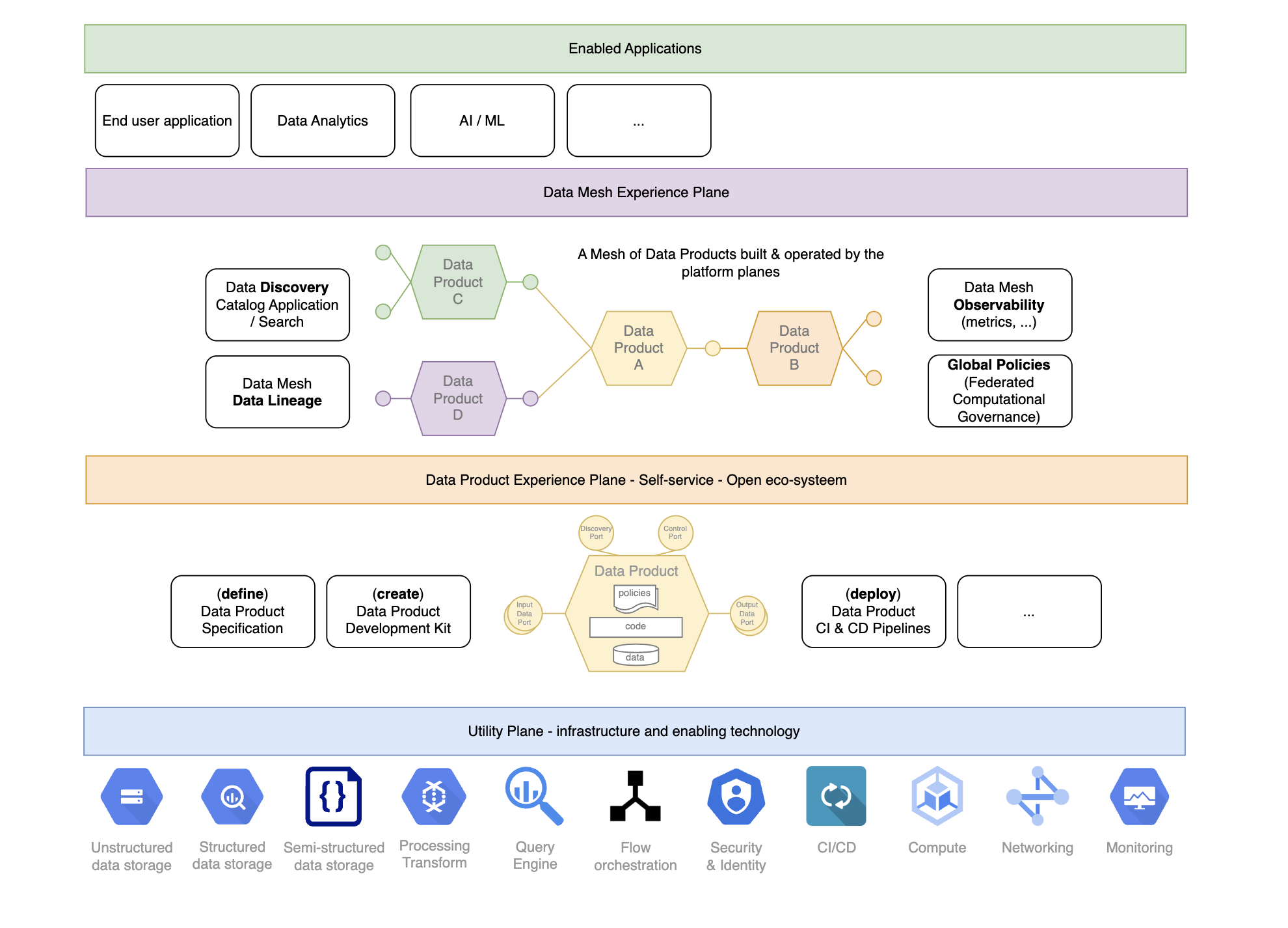
Conclusion
Adopting Data Mesh is a transformative journey for any organization. By breaking down the challenges into actionable steps, as ACA Group does, you can make Data Mesh more tangible, clarify its value, and align it with your organization's goals. These incremental actions serve to demystify Data Mesh, rendering it comprehensible to a wide array of stakeholders and facilitating well-informed decisions. Embracing Data Mesh represents an embrace of the future of data management, with its potential to unlock myriad possibilities for your organization. This journey is about making Data Mesh a practical reality while aligning it with your organizational objectives.
💡 Curious about what else Data Mesh has to offer you?
What others have also read
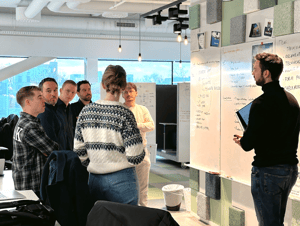
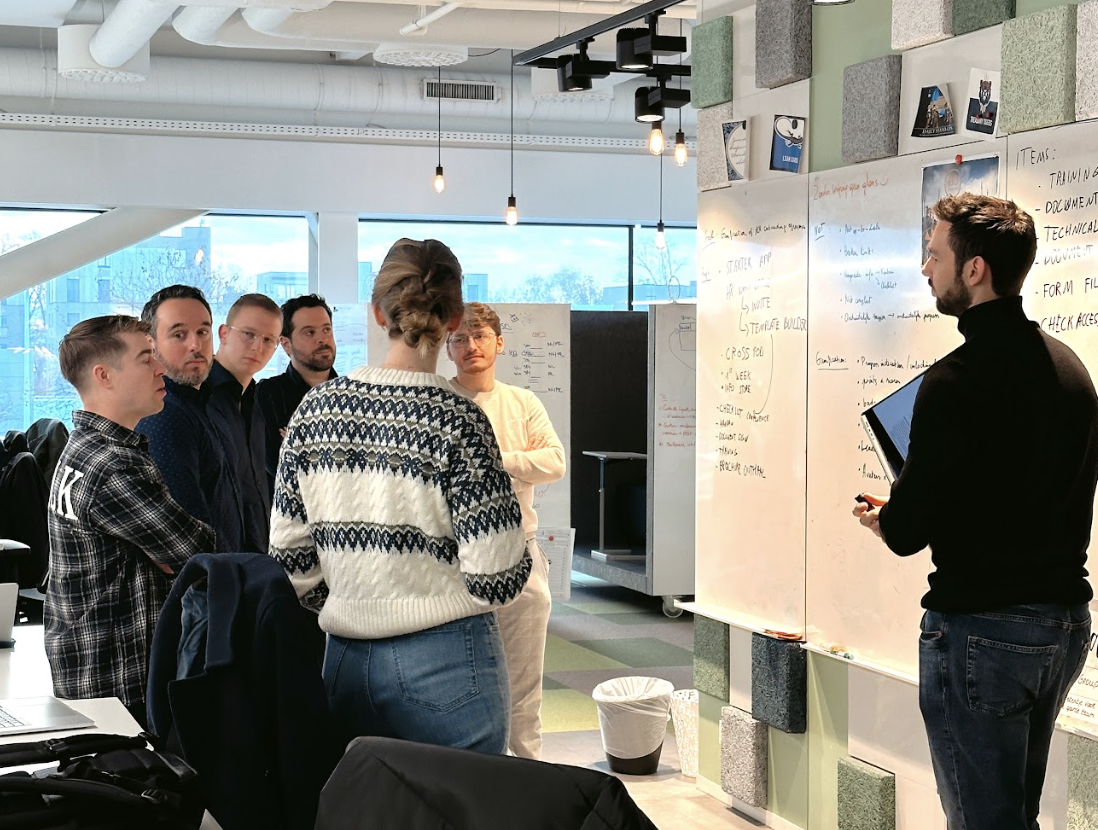
November 30, 2023 marked a highly anticipated day for numerous ACA employees. Because on Ship-IT Day, nine teams of ACA team members, whether or not supplemented with customer experts, delved into creating inventive solutions for customer challenges or for ACA Group itself. The hackathon proved to be both inspiring and productive, with at the end a deserved winner! The atmosphere in the ACA office in Hasselt was sizzling right from the early start. Eight out of the nine project teams were stationed here. During the coffee cake breakfast, you immediately felt that it was going to be an extraordinary day. There was a palpable sense of excitement among the project team members , as well as a desire to tackle the complex challenges ahead. 9 innovative projects for internal and external challenges 🚀 After breakfast, the eight project teams swarmed to their working habitat for the day. The ninth team competed in the ACA office in Leuven. We list the teams here: Chatbot course integration in customer portal System integration tests in a CI/CD pipeline Onboarding portal/platform including gamification Automatic dubbing, transcription and summary of conversations publiq film offering data import via ML SMOCS, Low level mock management system Composable data processing architecture Virtual employees Automated invoicing If you want to know more about the scope of the different project teams, read our first blog article Ship-IT Day 2023: all projects at a glance . Sensing the atmosphere in the teams Right before noon, we wondered how the teams had started and how their work was evolving. And so we went to take a quick look... 👀 1. Chatbot course integration in customer portal “After a short kick-off meeting with the customer, we divided the tasks and got to work straight away,” says Bernd Van Velsen. “The atmosphere is great and at the end of the day, we hope to present a result that will inspire the customer . In the best case, we will soon be able to use AI tools in a real customer project with the aim of making more optimal use of the customer's many data.” “The Ship-IT Day is an annual tradition that I like to participate in,” says Bernd. “Not only because it is great to collaborate with colleagues from other departments, but also because it is super educational.” 2. System integration tests in a CI/CD pipeline “We want to demonstrate that we can perform click tests in the frontend in an existing environment and verify whether everything works together properly,” says Stef Noten. “We can currently run the necessary tests locally, so we are good on schedule. The next step is to also make this work in our build pipeline. At the end of the day, we hope we will be able to run the tests either manually or scheduled on the latest version of the backend and frontend .” 3. Onboarding portal/platform including gamification The members of this project team all started at ACA fairly recently. And that is exactly what brought them together, because their goal was to develop a platform that makes the onboarding process for new employees more efficient and fun . Dieter Vennekens shared his enthusiasm with us, stating, "We kicked off with a brainstorming session to define the platform's requirements and goals. Subsequently, we reviewed these with the key users to ensure the final product aligns with their expectations. Our aim is to establish the basic structure before lunch, allowing us to focus on development and styling intensively in the afternoon. By the day's end, our objective is to unveil a functional prototype. This project serves as an opportunity to showcase the capabilities of Low-Code .” 4. Automatic dubbing, transcription and summary of conversations Upon entering their meeting room, we found the project team engrossed in their work, and Katrien Gistelinck provided a concise explanation for their business. "Our project is essentially divided into two aspects. Firstly, we aim to develop an automatic transcription and summary of a conversation . Concurrently, we are working on the live dubbing of a conversation, although we're uncertain about the feasibility of the latter within the day. It might be a tad ambitious, but we are determined to give it a try." She continued, "This morning, our focus was on defining the user flow and selecting the tools we'll utilize. Currently, multiple tasks are progressing simultaneously, addressing both the UI and backend components." 5. Publiq film offering data import via ML Comprising six publiq employees and three from ACA, this team engaged in an introductory round followed by a discussion of the project approach at the whiteboard. They then allocated tasks among themselves. Peter Jans mentioned, "Everyone is diligently working on their assigned tasks, and we maintain continuous communication. The atmosphere is positive, and we even took a group photo! Collaborating with the customer on a solution to a specific challenge for an entire day is energizing. " "At the close of the day, our objective is to present a functional demo showcasing the AI and ML (Machine Learning) processing of an email attachment, followed by the upload of the data to the UIT database. The outcome should be accessible on uitinvlaanderen.be ." Peter adds optimistically, "We're aiming for the win." That's the spirit, Peter! 6. SMOCS, Low level mock management system Upon our arrival, the SMOCS team was deeply engrossed in their discussions, making us hesitant to interrupt. Eventually, they graciously took the time to address our questions, and the atmosphere was undoubtedly positive. "We initiated the process with a brief brainstorming session at the whiteboard. After establishing our priorities, we allocated tasks accordingly. Currently, we are on track with our schedule: the design phase is largely completed, and substantial progress has been made with the API. We conduct a status check every hour, making adjustments as needed," they shared. "By the end of the day, our aim is to showcase an initial version of SMOCS , complete with a dashboard offering a comprehensive overview of the sent requests along with associated responses that we can adjust. Additionally, we have high hopes that the customized response will also show up in the end-user application." 7. Composable data processing architecture This project team aims to establish a basic architecture applicable to similar projects often centered around data collection and processing. Currently, customers typically start projects from scratch, while many building blocks could be reused via platform engineering and composable data. “Although time flies very quickly, we have already collected a lot of good ideas,” says Christopher Scheerlinck. “What do we want to present later? A very complex scheme that no one understands (laughs). No, we aspire to showcase our concepts for realizing a reusable architecture , which we can later pitch to the customer. Given that we can't provide a demo akin to other teams, we've already come to terms with the likelihood of securing second place!" 8. Virtual employees This team may have been the smallest of them all, but a lot of work had already been done just before noon. “This morning we first had a short meeting with the customer to discuss their expectations,” Remco Goyvaerts explains. “We then identified the priority tasks and both of us quickly got to work. The goal is to develop a virtual colleague who can be fed with new information based on AI and ML . This virtual colleague can help new employees find certain information without having to disturb other employees. I am sure that we will be able to show something beautiful, so at the moment the stress is well under control.” Chatbot technology is becoming more and more popular. Remco sees this Ship-IT project as the ideal opportunity to learn more about applications with long-term memory. “The Ship-It Day is a fantastic initiative,” says Remco. “It's wonderful to have the opportunity to break away from the routine work structure and explore innovative ideas.” 9. Automated invoicing The client involved in this project handles 50,000 invoices annually in various languages. The objective is to extract accurate information from these invoices, translate it into the appropriate language, and convert it into a format easily manageable for the customer . “Although we started quite late, we have already made great progress,” notes Bram Meerten. "We can already send the invoice to Azure, which extracts the necessary data reasonably well. Subsequently, we transmit that data to ChatGPT, yielding great results. Our focus now is on visualizing it in a frontend. The next phase involves implementing additional checks and solutions for line information that isn't processed correctly." Bram expresses enthusiasm for the Ship-IT Day concept, stating, "It's fun to start from scratch in the morning and present a functional solution at the end of the day. While it may not be finished to perfection, it will certainly be a nice prototype." And the winner is …. 🏆 At 5 p.m., the moment had arrived... Each team had the opportunity to showcase their accomplishments in a 5-minute pitch, followed by a voting session where everyone present could choose their favorite. All teams successfully presented a functional prototype addressing their customer's challenges. While the SMOCS team may not have managed to visualize their solution, they introduced additional business ideas with the SMOCintosh and the SMOCS-to-go food concept. However, these ideas fell just short of securing victory. In a thrilling final showdown, the team working on the onboarding platform for ACA came out as the winners! Under the name NACA (New at ACA), they presented an impressive prototype of the onboarding platform, where employees gradually build a rocket while progressing through their onboarding journey. Not only was the functionality noteworthy, but the user interface also received high praise. Congratulations to the well-deserving winners! Enjoy your shopping and dinner vouchers. 🤩 See you next year!
Read more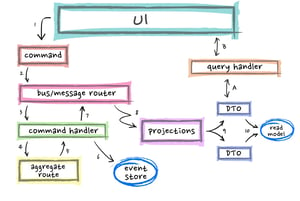
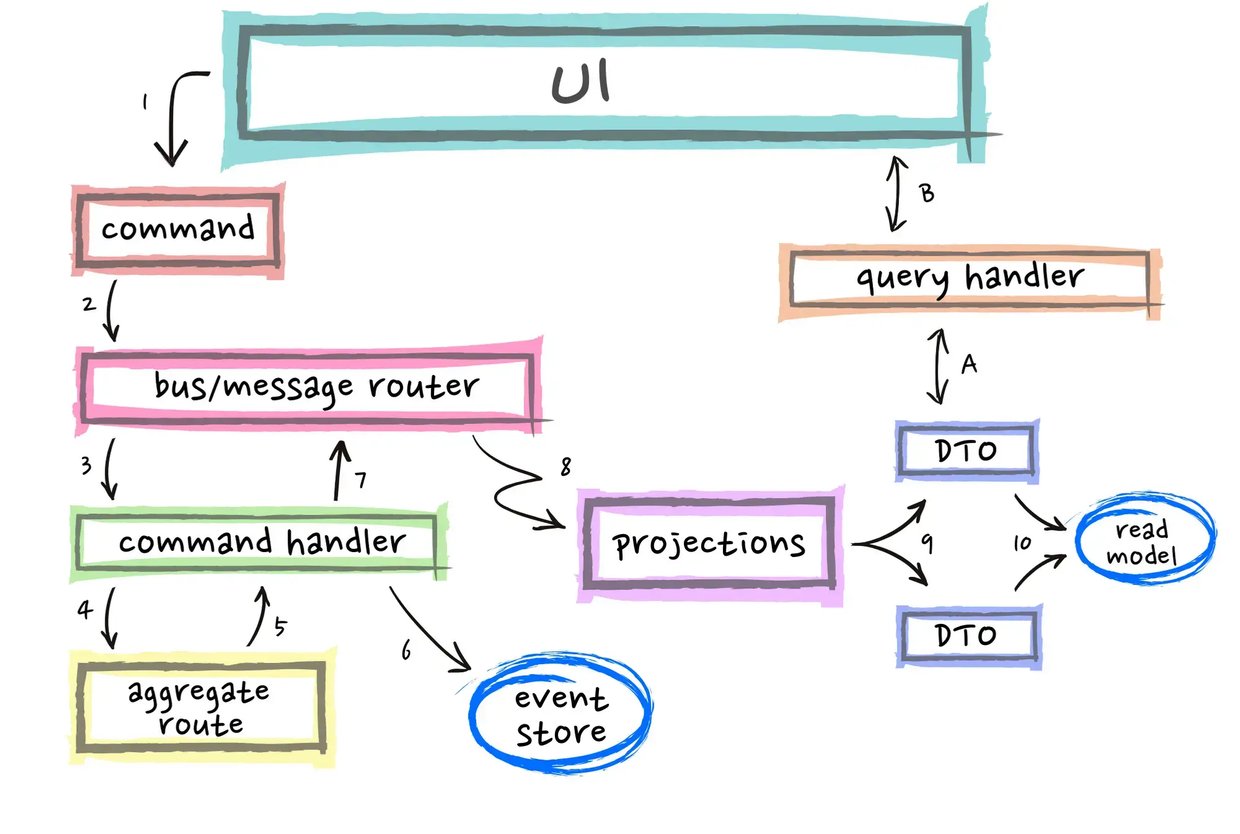
Staying current with the latest trends and best practices is crucial in the rapidly evolving world of software development. Innovative approaches like EventSourcing and CQRS can enable developers to build flexible, scalable, and secure systems. At Domain-Driven Design (DDD) Europe 2022 , Paolo Banfi delivered an enlightening talk on these two techniques. What is EventSourcing? EventSourcing is an innovative approach to data storage that prioritises the historical context of an object. Rather than just capturing the present state of an object, EventSourcing stores all the events that led to that state. Creating a well-designed event model is critical when implementing EventSourcing. The event model defines the events that will be stored and how they will be structured. Careful planning of the event model is crucial because it affects the ease of data analysis. Modifying the event model after implementation can be tough, so it's important to get it right from the beginning. What is CQRS CQRS (Command Query Responsibility Segregation) is a technique that separates read and write operations in a system to improve efficiency and understandability. In a traditional architecture, an application typically interacts with a database using a single interface. However, CQRS separates the read and write operations, each of which is handled by different components. Combining EventSourcing and CQRS One of the advantages of combining EventSourcing and CQRS is that it facilitates change tracking and data auditing. By keeping track of all the events that led to a particular state, it's easier to track changes over time. This can be particularly useful for applications that require auditing or regulation. Moreover, separating read and write operations in this way provides several benefits. Firstly, it optimises the system by reducing contention and improving scalability. Secondly, it simplifies the system by isolating the concerns of each side. Finally, it enhances the security of sensitive data by limiting access to the write side of the system. Another significant advantage of implementing CQRS is the elimination of the need to traverse the entire event stream to determine the current state. By separating read and write operations, the read side of the system can maintain dedicated models optimised for querying and retrieving specific data views. As a result, when querying the system for the latest state, there is no longer a requirement to traverse the entire event stream. Instead, the optimised read models can efficiently provide the necessary data, leading to improved performance and reduced latency. When to use EventSourcind and CQRS It's important to note that EventSourcing and CQRS may not be suitable for every project. Implementing EventSourcing and CQRS can require more work upfront compared to traditional approaches. Developers need to invest time in understanding and implementing these approaches effectively. However, for systems that demand high scalability, flexibility or security, EventSourcing and CQRS can provide an excellent solution. Deciding whether to use CQRS or EventSourcing for your application depends on various factors, such as the complexity of your domain model, the scalability requirements, and the need for a comprehensive audit trail of system events. Developers must evaluate the specific needs of their project before deciding whether to use these approaches. CQRS is particularly useful for applications with complex domain models that require different data views for different use cases. By separating the read and write operations into distinct models, you can optimise the read operations for performance and scalability, while still maintaining a single source of truth for the data. Event Sourcing is ideal when you need to maintain a complete and accurate record of all changes to your system over time. By capturing every event as it occurs and storing it in an append-only log, you can create an immutable audit trail that can be used for debugging, compliance, and other purposes. Conclusion The combination of EventSourcing and CQRS can provide developers with significant benefits, such as increased flexibility, scalability and security. They offer a fresh approach to software development that can help developers create applications that are more in line with the needs of modern organisations. If you're interested in learning more about EventSourcing and CQRS, there are plenty of excellent resources available online. Conferences and talks like DDD Europe are also excellent opportunities to stay up-to-date on the latest trends and best practices in software development. Make sure not to miss out on these opportunities if you want to stay ahead of the game! The next edition of Domain-Driven Design Europe will take place in Amsterdam from the 5th to the 9th of June 2023. Did you know that ACA Group is one of the proud sponsors of DDD Europe? {% module_block module "widget_bc90125a-7f60-4a63-bddb-c60cc6f4ee41" %}{% module_attribute "buttons" is_json="true" %}{% raw %}[{"appearance":{"link_color":"light","primary_color":"primary","secondary_color":"primary","tertiary_color":"light","tertiary_icon_accent_color":"dark","tertiary_text_color":"dark","variant":"primary"},"content":{"arrow":"right","icon":{"alt":null,"height":null,"loading":"disabled","size_type":null,"src":"","width":null},"tertiary_icon":{"alt":null,"height":null,"loading":"disabled","size_type":null,"src":"","width":null},"text":"More about ACA Group"},"target":{"link":{"no_follow":false,"open_in_new_tab":false,"rel":"","sponsored":false,"url":{"content_id":null,"href":"https://acagroup.be/en/aca-as-a-company/","href_with_scheme":"https://acagroup.be/en/aca-as-a-company/","type":"EXTERNAL"},"user_generated_content":false}},"type":"normal"}]{% endraw %}{% end_module_attribute %}{% module_attribute "child_css" is_json="true" %}{% raw %}{}{% endraw %}{% end_module_attribute %}{% module_attribute "css" is_json="true" %}{% raw %}{}{% endraw %}{% end_module_attribute %}{% module_attribute "definition_id" is_json="true" %}{% raw %}null{% endraw %}{% end_module_attribute %}{% module_attribute "field_types" is_json="true" %}{% raw %}{"buttons":"group","styles":"group"}{% endraw %}{% end_module_attribute %}{% module_attribute "isJsModule" is_json="true" %}{% raw %}true{% endraw %}{% end_module_attribute %}{% module_attribute "label" is_json="true" %}{% raw %}null{% endraw %}{% end_module_attribute %}{% module_attribute "module_id" is_json="true" %}{% raw %}201493994716{% endraw %}{% end_module_attribute %}{% module_attribute "path" is_json="true" %}{% raw %}"@projects/aca-group-project/aca-group-app/components/modules/ButtonGroup"{% endraw %}{% end_module_attribute %}{% module_attribute "schema_version" is_json="true" %}{% raw %}2{% endraw %}{% end_module_attribute %}{% module_attribute "smart_objects" is_json="true" %}{% raw %}null{% endraw %}{% end_module_attribute %}{% module_attribute "smart_type" is_json="true" %}{% raw %}"NOT_SMART"{% endraw %}{% end_module_attribute %}{% module_attribute "tag" is_json="true" %}{% raw %}"module"{% endraw %}{% end_module_attribute %}{% module_attribute "type" is_json="true" %}{% raw %}"module"{% endraw %}{% end_module_attribute %}{% module_attribute "wrap_field_tag" is_json="true" %}{% raw %}"div"{% endraw %}{% end_module_attribute %}{% end_module_block %}
Read more

In the ever-evolving landscape of data management, investing in platforms and navigating migrations between them is a recurring theme in many data strategies. How can we ensure that these investments remain relevant and can evolve over time, avoiding endless migration projects? The answer lies in embracing ‘Composability’ - a key principle for designing robust, future-proof data (mesh) platforms. Is there a silver bullet we can buy off-the-shelf? The data-solution market is flooded with data vendor tools positioning themselves as the platform for everything, as the all-in-one silver bullet. It's important to know that there is no silver bullet. While opting for a single off-the-shelf platform might seem like a quick and easy solution at first, it can lead to problems down the line. These monolithic off-the-shelf platforms often end up inflexible to support all use cases, not customizable enough, and eventually become outdated.This results in big complicated migration projects to the next silver bullet platform, and organizations ending up with multiple all-in-one platforms, causing disruptions in day-to-day operations and hindering overall progress. Flexibility is key to your data mesh platform architecture A complete data platform must address numerous aspects: data storage, query engines, security, data access, discovery, observability, governance, developer experience, automation, a marketplace, data quality, etc. Some vendors claim their all-in-one data solution can tackle all of these. However, typically such a platform excels in certain aspects, but falls short in others. For example, a platform might offer a high-end query engine, but lack depth in features of the data marketplace included in their solution. To future-proof your platform, it must incorporate the best tools for each aspect and evolve as new technologies emerge. Today's cutting-edge solutions can be outdated tomorrow, so flexibility and evolvability are essential for your data mesh platform architecture. Embrace composability: Engineer your future Rather than locking into one single tool, aim to build a platform with composability at its core. Picture a platform where different technologies and tools can be seamlessly integrated, replaced, or evolved, with an integrated and automated self-service experience on top. A platform that is both generic at its core and flexible enough to accommodate the ever-changing landscape of data solutions and requirements. A platform with a long-term return on investment by allowing you to expand capabilities incrementally, avoiding costly, large-scale migrations. Composability enables you to continually adapt your platform capabilities by adding new technologies under the umbrella of one stable core platform layer. Two key ingredients of composability Building blocks: These are the individual components that make up your platform. Interoperability: All building blocks must work together seamlessly to create a cohesive system. An ecosystem of building blocks When building composable data platforms, the key lies in sourcing the right building blocks. But where do we get these? Traditional monolithic data platforms aim to solve all problems in one package, but this stifles the flexibility that composability demands. Instead, vendors should focus on decomposing these platforms into specialized, cost-effective components that excel at addressing specific challenges. By offering targeted solutions as building blocks, they empower organizations to assemble a data platform tailored to their unique needs. In addition to vendor solutions, open-source data technologies also offer a wealth of building blocks. It should be possible to combine both vendor-specific and open-source tools into a data platform tailored to your needs. This approach enhances agility, fosters innovation, and allows for continuous evolution by integrating the latest and most relevant technologies. Standardization as glue between building blocks To create a truly composable ecosystem, the building blocks must be able to work together, i.e. interoperability. This is where standards come into play, enabling seamless integration between data platform building blocks. Standardization ensures that different tools can operate in harmony, offering a flexible, interoperable platform. Imagine a standard for data access management that allows seamless integration across various components. It would enable an access management building block to list data products and grant access uniformly. Simultaneously, it would allow data storage and serving building blocks to integrate their data and permission models, ensuring that any access management solution can be effortlessly composed with them. This creates a flexible ecosystem where data access is consistently managed across different systems. The discovery of data products in a catalog or marketplace can be greatly enhanced by adopting a standard specification for data products. With this standard, each data product can be made discoverable in a generic way. When data catalogs or marketplaces adopt this standard, it provides the flexibility to choose and integrate any catalog or marketplace building block into your platform, fostering a more adaptable and interoperable data ecosystem. A data contract standard allows data products to specify their quality checks, SLOs, and SLAs in a generic format, enabling smooth integration of data quality tools with any data product. It enables you to combine the best solutions for ensuring data reliability across different platforms. Widely accepted standards are key to ensuring interoperability through agreed-upon APIs, SPIs, contracts, and plugin mechanisms. In essence, standards act as the glue that binds a composable data ecosystem. A strong belief in evolutionary architectures At ACA Group, we firmly believe in evolutionary architectures and platform engineering, principles that seamlessly extend to data mesh platforms. It's not about locking yourself into a rigid structure but creating an ecosystem that can evolve, staying at the forefront of innovation. That’s where composability comes in. Do you want a data platform that not only meets your current needs but also paves the way for the challenges and opportunities of tomorrow? Let’s engineer it together Ready to learn more about composability in data mesh solutions? {% module_block module "widget_f1f5c870-47cf-4a61-9810-b273e8d58226" %}{% module_attribute "buttons" is_json="true" %}{% raw %}[{"appearance":{"link_color":"light","primary_color":"primary","secondary_color":"primary","tertiary_color":"light","tertiary_icon_accent_color":"dark","tertiary_text_color":"dark","variant":"primary"},"content":{"arrow":"right","icon":{"alt":null,"height":null,"loading":"disabled","size_type":null,"src":"","width":null},"tertiary_icon":{"alt":null,"height":null,"loading":"disabled","size_type":null,"src":"","width":null},"text":"Contact us now!"},"target":{"link":{"no_follow":false,"open_in_new_tab":false,"rel":"","sponsored":false,"url":{"content_id":230950468795,"href":"https://25145356.hs-sites-eu1.com/en/contact","href_with_scheme":null,"type":"CONTENT"},"user_generated_content":false}},"type":"normal"}]{% endraw %}{% end_module_attribute %}{% module_attribute "child_css" is_json="true" %}{% raw %}{}{% endraw %}{% end_module_attribute %}{% module_attribute "css" is_json="true" %}{% raw %}{}{% endraw %}{% end_module_attribute %}{% module_attribute "definition_id" is_json="true" %}{% raw %}null{% endraw %}{% end_module_attribute %}{% module_attribute "field_types" is_json="true" %}{% raw %}{"buttons":"group","styles":"group"}{% endraw %}{% end_module_attribute %}{% module_attribute "isJsModule" is_json="true" %}{% raw %}true{% endraw %}{% end_module_attribute %}{% module_attribute "label" is_json="true" %}{% raw %}null{% endraw %}{% end_module_attribute %}{% module_attribute "module_id" is_json="true" %}{% raw %}201493994716{% endraw %}{% end_module_attribute %}{% module_attribute "path" is_json="true" %}{% raw %}"@projects/aca-group-project/aca-group-app/components/modules/ButtonGroup"{% endraw %}{% end_module_attribute %}{% module_attribute "schema_version" is_json="true" %}{% raw %}2{% endraw %}{% end_module_attribute %}{% module_attribute "smart_objects" is_json="true" %}{% raw %}null{% endraw %}{% end_module_attribute %}{% module_attribute "smart_type" is_json="true" %}{% raw %}"NOT_SMART"{% endraw %}{% end_module_attribute %}{% module_attribute "tag" is_json="true" %}{% raw %}"module"{% endraw %}{% end_module_attribute %}{% module_attribute "type" is_json="true" %}{% raw %}"module"{% endraw %}{% end_module_attribute %}{% module_attribute "wrap_field_tag" is_json="true" %}{% raw %}"div"{% endraw %}{% end_module_attribute %}{% end_module_block %}
Read moreWant to dive deeper into this topic?
Get in touch with our experts today. They are happy to help!

Want to dive deeper into this topic?
Get in touch with our experts today. They are happy to help!

Want to dive deeper into this topic?
Get in touch with our experts today. They are happy to help!

Want to dive deeper into this topic?
Get in touch with our experts today. They are happy to help!

